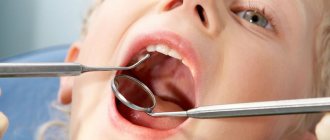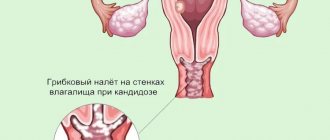The cause of bad breath is not always found in the mouth. Especially when the most common causes, for example, pathology of the oral cavity or stomach, have already been excluded - perhaps the source of the unpleasant odor is located deeper.
It is purulent inflammation that often leads to the formation of a “bad” odor. If it is in the mouth, the cause is usually discovered quickly. On the other hand, in the case of inflammation outside the mouth, additional diagnostics may be required to find the cause of bad breath.
Bad breath
The content of the article
Bad breath (stench ex ore, halitosis) is the first symptom of diseases of the gastrointestinal tract. In approximately 90% of cases, the unwanted odor comes directly from the mouth; in the rest, the source of the odor is other parts of the gastrointestinal tract.
The causes of bad breath are multifactorial:
- diseases of the upper gastrointestinal tract;
- respiratory system;
- some systemic diseases;
- metabolic disorders;
- taking medications;
- malignant tumors.
An unpleasant odor is most often the result of the action of bacteria that break down organic substances present in saliva, exfoliated epithelium and food debris. The main products of this decomposition are volatile sulfur compounds. Normal oral flora consists of gram (+) and gram (-) granulomas and bacilli. The source of bad breath most often is the waste products of gram (-) anaerobes.
A breakthrough in research on this issue occurred in 1934, when scientists designed an osmoscope that allowed a semi-quantitative assessment of odor intensity. In the 1970s, gas chromatography was used to identify VSC as the main cause of odor.
The identified compounds are:
- hydrogen sulfide (H 2 S);
- methanethiol - methyl mercaptan (CH 3 SH);
- dimethyl sulfide (CH 3 SCH 3).
Today, halimeters are used to assess the presence and concentration of volatile sulfur compounds in exhaled air. Gastroenterologists also have a test that determines the activity of enzymes in saliva, which proves the presence of bacteria that produce volatile sulfur compounds.
Other causes of bad breath include: smoking, drinking alcohol and drinking coffee. In these cases, it is easy to determine the cause of bad breath.
Bad breath due to oral diseases
Bad breath in diseases of the oral cavity
Causes of bad breath in diseases of the oral cavity:
- coating on the tongue;
- periodontal disease (including tissue around implants);
- widespread caries;
- ulcers in the mucous membrane;
- food debris between teeth and in gum pockets;
- uncleaned teeth and dentures;
- the contents of the cysts flowing into the oral cavity through the fistula;
- cancerous lesions of the oral cavity;
- factors that reduce saliva production.
The most common source of unpleasant odor is the layer that covers the top of the tongue. It consists of thickened saliva, bacteria, exfoliated epithelium and food debris. The smell intensifies with anatomical defects of the tongue - cracks and cuts, ulcerations on the tongue, hairy tongue. Improper use of a brush when cleaning the tongue leads to the formation of ulcers.
Is wax in the ear normal or pathological?
Purulent, mucous, or other discharge may appear in the ear. As for the organ of hearing, another secret is added to this list - the mass of sulfur. The latter is the most common form of ear discharge.
Wax is formed in the external auditory canal. The latter extends from the visible part of the ear to the middle ear. The skin in this area contains certain glands that produce sulfur. After leaving the glands, the wax slowly moves to the visible part of the ear and either on its own or leaves the ear during washing.
The ear glands constantly produce wax, so there is always enough wax in the ear canal.
Earwax performs several important functions.
- It moisturizes the skin of the ear canal, preventing the ear from drying out.
- Contains chemicals that destroy harmful microbes and protect us from infection.
- Sulfur is a kind of shield erected between the outside world and the internal structures of the ear. When dust, dirt and other unwanted particles enter the ear, wax absorbs them and prevents them from penetrating deep into the ear. So her disappearance cannot bring anything good. Therefore, it is a mistake to inexorably fight sulfur - you cannot get rid of it, and there is no need for this.
Regular washing is enough to keep your ear clean. You can also clean the outer ear with a towel to remove wax. But under no circumstances use cotton swabs or other long objects - the hearing aid and membrane are very soft and easily damaged.
In addition, pressure can cause wax to penetrate deeper into the ear. Be careful: While wax is designed to prevent harmful particles from getting deep into the ear, you'll be doing the opposite if you're extra active.
Bad breath in ENT diseases
Patients with ear, nose, or throat diseases often complain of bad breath. Reasons include:
- viral and bacterial pharyngitis;
- tonsillitis;
- deep crypts in the tonsils;
- sinusitis of the nose;
- foreign bodies in the nasal cavity or sinuses;
- nasal discharge with an unpleasant odor.
Due to difficulty in nasal breathing, the oral cavity dries out, which accelerates the detachment of the epithelium and the formation of plaque on the tongue.
How can mycetoma be cured?
Is it possible to do without surgery? It is impossible to get rid of fungus in the maxillary sinus without surgical intervention, I will say this right away. No pills, no drops of “dancing with a tambourine” and everything else will give the desired therapeutic effect. First of all, it is necessary to surgically remove the fungal body, remove this mycelium, remove all the fungus from the maxillary sinus.
This can be done either through a nasal surgical approach or an intraoral approach.
How to remove fungus from the maxillary sinus
With intraoral access, a perforation is made in the vestibular wall of the maxillary sinus - access, and evacuation occurs through this hole, i.e. removal of the fungal body, mushroom mycelium. Then the maxillary sinus is well washed, treated with antifungal and antimicrobial drugs and sutured. Subsequently, the patient is prescribed antifungal therapy.
Surgical removal of mycetoma shows good results today, relapses are extremely rare.
Bad breath due to gastrointestinal diseases
Bad breath in gastrointestinal diseases
Halitosis can be caused by diseases of the digestive tract, in which bacterial flora producing volatile sulfur compounds develops on the remains of dead tissue (for example, on the edges of ulcers), blood clots and food debris. Common pathologies:
- Gastroesophageal reflux disease (GERD);
- Zenker's diverticulum;
- Achalasia of the esophagus;
- Gastritis;
- Peptic ulcer;
- Tumors of the esophagus;
- Stomach cancer;
- Diseases in which there is an overproduction of volatile compounds with odor;
- Intestinal malabsorption syndromes (associated with excessive gas formation in the intestines);
- Liver failure associated with the accumulation of ammonia and other breakdown products of amino acids, causing an unpleasant odor, especially intense in hepatic encephalopathy.
The existence of halitosis caused by H. pylori infection is a controversial issue.
Other causes of bad breath
Other causes of bad breath include:
- Chronic kidney disease (most often the result of glomerulonephritis), during which the concentration of urea in the blood increases. The exhaled air smells of ammonia, the patient has a salty taste in the mouth;
- Improperly treated diabetes, leading to the accumulation of ketone compounds, giving the exhaled air the characteristic smell of acetone. Diabetes often presents with dry mouth;
- Trimethylaminuria (fish odor syndrome) is a genetically determined metabolic disease that disrupts the oxidative pathway of trimethylamine in the liver. Excessive amounts of trimethylamine in the exhaled air cause bad breath.
Diagnosis of bad oral odor
Diagnosis of bad breath
Bad breath leaves many unpleasant moments for the patient and the people around him. Therefore, when a smell appears in the mouth, patients first resort to unconventional methods of control, which include enhanced oral hygiene. And only when these methods do not produce results do they turn to a gastroenterologist for help.
Diagnosis of bad breath is a prerequisite for successful treatment of bad breath. The doctor begins with a thorough history and physical examination. Particular attention is paid to:
- rules of oral hygiene);
- the moment and circumstances associated with the occurrence of bad breath;
- dietary habits;
- condition of the oral cavity;
- respiratory symptoms.
Treatment options
To get rid of the smell, you need to find out the cause of its appearance.
The method of treating such a condition largely depends on the specific cause of the disease, its form, neglect, as well as the presence of concomitant pathologies in the patient.
Today, three main treatment methods are practiced: drug therapy, surgery, and folk remedies. The selection of treatment measures should be carried out exclusively by the attending physician. Self-medication in this condition is unacceptable.
Classic drug therapy involves the use of the following drugs:
- For bacteriological damage, antibiotics are used.
- Prescription of analgesics and antispasmodics (No-Shpa).
- Rinse the nasal cavity with saline solution and hydrogen peroxide.
- Installation of turundas soaked in medicinal solutions.
- Rinse the nose with a solution of sea salt.
UHF therapy and electrophoresis are used as physiotherapy procedures.
Important! If the root cause of the disease is systemic diseases of the internal organs, the main treatment should be aimed at eliminating them. Only by curing the source of the disease will it be possible to get rid of the symptoms that it provokes.
Most likely you need to contact an ENT specialist.
Different specialists can treat bad odor from the nasopharynx. This will depend on the specific provoking factor of the disease. The patient may need to consult a dentist, ENT doctor, gastroenterologist, or therapist. If the disease is in an advanced form, surgery may be required.
As an auxiliary therapy, it is allowed to practice traditional treatment. With its help you can not only eliminate bad odor, but also get rid of pain and inflammation. The most effective folk remedies for this purpose are:
- Regular rinsing of the nasal passages with a solution of water and aloe plant juice.
- Rinse the nose with a warm solution of sea salt.
- Grind one onion to a porridge state, add a spoonful of water and the same amount of honey. Leave for half an hour and strain. Place three drops of the prepared liquid in your nose several times a day.
- Take equal amounts of mint, sage and wormwood. Pour 1 liter of boiling water over a spoonful of the mixture. Leave for an hour. Strain and take a third of a glass 3 times a day.
Children, pregnant women, elderly patients, as well as those who suffer from severe chronic diseases should use traditional methods with extreme caution and only after permission from a doctor.
Differentiation of bad breath and halitophobia
A thorough examination can determine whether the problem is true halitosis or pseudohalitosis (halitophobia). If halitophobia is suspected, the doctor interviews the patient’s relatives. If they do not confirm the frequent occurrence of bad breath in the patient, it is likely that this symptom is a subjective sensation of the patient. In doubtful cases, a galimeter is used.
In most cases, a properly performed clinical examination can determine the cause of bad breath.
Sulfur plug
Some people's ears produce large amounts of wax. When sulfur accumulates in excess or is too thick to be removed naturally, a sulfur blockage forms.
Sulfur plug
It may also be that the blockage is caused by trying to clear the ear with a cotton swab or other object. In this case, the wax not only cannot come out, but also penetrates deeper into the ear, so it is much more difficult to expel.
Sulfur plug is manifested by the following symptoms:
- Earache;
- Feeling of fullness, swelling on the affected side with hearing impairment;
- Tinnitus (tinnitus);
- Dizziness.
If you experience these symptoms, consult your doctor.
Note. Similar clinical signs are characteristic of a number of ear diseases. You cannot determine whether the cause of your complaints is sulfur blockage or another pathology; this is the prerogative of the doctor, so do not try to solve the problem yourself.
Removing excess wax is also best left to a doctor - your attempts may rupture the eardrum and cause serious complications. Your doctor will prescribe a medicine that softens the wax and helps get rid of it.
If treatment with ear drops does not help, irrigation (rinsing) is performed. This is an invasive procedure performed by a doctor.
If wax blockage occurs frequently, special drops may also be prescribed for preventive purposes, although at present there is no way to completely prevent the problem from recurring.











